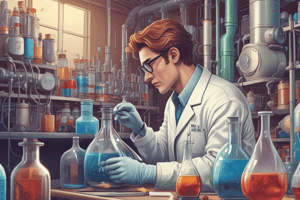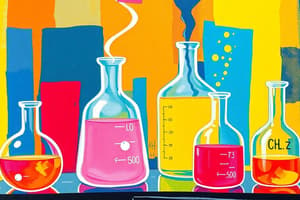Podcast
Questions and Answers
Which lab equipment is specifically designed to hold, mix, and heat chemical samples?
Which lab equipment is specifically designed to hold, mix, and heat chemical samples?
Which of the following is a chemical property?
Which of the following is a chemical property?
What is the primary function of a glass stir rod?
What is the primary function of a glass stir rod?
Which of the following lab equipment is best suited for performing reactions involving small volumes of chemicals?
Which of the following lab equipment is best suited for performing reactions involving small volumes of chemicals?
Signup and view all the answers
Which of these is NOT a chemical change?
Which of these is NOT a chemical change?
Signup and view all the answers
Which hazard category symbol represents a substance that could potentially cause damage to both metals and skin?
Which hazard category symbol represents a substance that could potentially cause damage to both metals and skin?
Signup and view all the answers
Which hazard category symbol is associated with substances that may cause damage to the aquatic environment?
Which hazard category symbol is associated with substances that may cause damage to the aquatic environment?
Signup and view all the answers
Which statement accurately describes why the Safety Data Sheet (SDS) is important to refer to?
Which statement accurately describes why the Safety Data Sheet (SDS) is important to refer to?
Signup and view all the answers
Which hazard category is associated with the potential for an explosion when the substance is exposed to certain conditions?
Which hazard category is associated with the potential for an explosion when the substance is exposed to certain conditions?
Signup and view all the answers
Which hazard category symbol most likely indicates a substance with a potential for causing serious health effects, possibly leading to death, even with short exposure to small amounts?
Which hazard category symbol most likely indicates a substance with a potential for causing serious health effects, possibly leading to death, even with short exposure to small amounts?
Signup and view all the answers
What is a common characteristic of alkali metals?
What is a common characteristic of alkali metals?
Signup and view all the answers
How are elements in the same group of the periodic table similar?
How are elements in the same group of the periodic table similar?
Signup and view all the answers
Which of the following statements is true about noble gases?
Which of the following statements is true about noble gases?
Signup and view all the answers
What distinguishes metalloids from metals and non-metals?
What distinguishes metalloids from metals and non-metals?
Signup and view all the answers
What are lanthanides and actinides primarily known for?
What are lanthanides and actinides primarily known for?
Signup and view all the answers
Which of the following properties would be most useful in identifying vinegar?
Which of the following properties would be most useful in identifying vinegar?
Signup and view all the answers
Based on its position in the Periodic Table, what is the charge of the ion formed by phosphorus?
Based on its position in the Periodic Table, what is the charge of the ion formed by phosphorus?
Signup and view all the answers
Which of the following is an example of a chemical property?
Which of the following is an example of a chemical property?
Signup and view all the answers
Which element in the table has the most valence electrons?
Which element in the table has the most valence electrons?
Signup and view all the answers
Why are Group 1 elements highly reactive?
Why are Group 1 elements highly reactive?
Signup and view all the answers
Which option is an example of a chemical change?
Which option is an example of a chemical change?
Signup and view all the answers
Which term describes a substance that allows light to pass through but not clearly?
Which term describes a substance that allows light to pass through but not clearly?
Signup and view all the answers
What does a drastic color change in a reaction typically indicate?
What does a drastic color change in a reaction typically indicate?
Signup and view all the answers
In ionic bonding, what happens to metals?
In ionic bonding, what happens to metals?
Signup and view all the answers
How many electrons does oxygen typically share with other elements?
How many electrons does oxygen typically share with other elements?
Signup and view all the answers
What does the subscript in a chemical formula denote?
What does the subscript in a chemical formula denote?
Signup and view all the answers
What would imply that a mixture is undergoing a physical change?
What would imply that a mixture is undergoing a physical change?
Signup and view all the answers
Which of the following pairs are both classified as a chemical change?
Which of the following pairs are both classified as a chemical change?
Signup and view all the answers
Which observation is NOT considered evidence of a chemical change?
Which observation is NOT considered evidence of a chemical change?
Signup and view all the answers
What is the primary reason for atoms to bond together?
What is the primary reason for atoms to bond together?
Signup and view all the answers
Which of the following steps in the scientific method is most closely associated with recording data in a structured way?
Which of the following steps in the scientific method is most closely associated with recording data in a structured way?
Signup and view all the answers
What kind of observation is it when you note that a substance changes color during a reaction?
What kind of observation is it when you note that a substance changes color during a reaction?
Signup and view all the answers
Consider the following hypothesis: "If I add heat to ice, it will melt." Which step of the scientific method does this statement belong to?
Consider the following hypothesis: "If I add heat to ice, it will melt." Which step of the scientific method does this statement belong to?
Signup and view all the answers
In scientific method, what is the difference between a hypothesis and a conclusion?
In scientific method, what is the difference between a hypothesis and a conclusion?
Signup and view all the answers
Which of these is an example of an inference rather than a direct observation?
Which of these is an example of an inference rather than a direct observation?
Signup and view all the answers
Which of the following is a characteristic of a chemical change?
Which of the following is a characteristic of a chemical change?
Signup and view all the answers
What evidence can indicate a physical change occurred?
What evidence can indicate a physical change occurred?
Signup and view all the answers
Which of the following properties describes how a substance can change into a new substance?
Which of the following properties describes how a substance can change into a new substance?
Signup and view all the answers
What key distinction separates a physical change from a chemical change?
What key distinction separates a physical change from a chemical change?
Signup and view all the answers
Which of these would NOT be classified as a physical property?
Which of these would NOT be classified as a physical property?
Signup and view all the answers
What does WHMIS stand for?
What does WHMIS stand for?
Signup and view all the answers
Which description corresponds to a symbol indicating 'may cause or suspected of causing serious health effects'?
Which description corresponds to a symbol indicating 'may cause or suspected of causing serious health effects'?
Signup and view all the answers
Which lab equipment is specifically designed for accurate measurement of liquid volume?
Which lab equipment is specifically designed for accurate measurement of liquid volume?
Signup and view all the answers
Which hazard symbol represents a substance that could be explosively reactive?
Which hazard symbol represents a substance that could be explosively reactive?
Signup and view all the answers
Study Notes
Lab Equipment and Uses
- Rusting is a chemical process, producing a new substance.
- Chemical properties are evident during or after a chemical reaction.
- Rotting is a chemical change, involving a chemical reaction.
- Erlenmeyer flasks hold liquids, possibly releasing gases.
- Glass stir rods are for stirring solutions.
- Spot plates are for small reactions at a time.
- Test tubes hold, mix, and heat chemicals.
- Beakers hold liquid or solid samples, or for reactions.
- Electronic balances measure the mass of substances accurately.
- Beaker, a piece of scientific equipment often used in the lab for mixing chemicals, holding solutions, or even heating substances.
- Graduated cylinders are used to measure the volume of liquids.
- Funnels are used to pour liquids into containers with small openings.
Studying That Suits You
Use AI to generate personalized quizzes and flashcards to suit your learning preferences.
Related Documents
Description
This quiz explores various lab equipment and their uses in chemical processes. It covers topics such as rusting, rotting, and the properties of different lab tools. Test your understanding of laboratory practices and the significance of chemical reactions.




